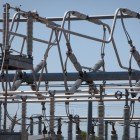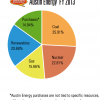Background
The Electric Reliability Council of Texas, or ERCOT, is a membership-based, non-profit council that provides electric power to approximately 23 million people in Texas. ERCOT customers use about 85 percent of the state’s electric power. Unlike many other states in the nation, Texas’ electric grid is not connected to the rest of the national grid. The Texas Legislature and the Public Utility Commission of Texas (PUC) have primary jurisdiction over ERCOT.
Created in 1970, ERCOT was the successor to the Texas Interconnected System (TIS). TIS was formed at the beginning World War II to provide power for aluminum smelting companies located along the Gulf Coast. In 1981, ERCOT became the central operating coordinator for Texas electricity. Later, in 1996, ERCOT became the original electric utility industry Independent System Operator (ISO) in the U.S. ERCOT is now one of ten electric utility industry ISOs in North America.
In September 2003, the state legislature and PUC ordered ERCOT to transition from a wholesale electric market with four large regions to a marketplace made up of more than 4,000 nodes throughout the state. This undertaking, called the Nodal Project, aims to improve the efficiency of the grid by having more specific information for different locations throughout the state.
In 2006, Texas surpassed California in wind-power production, to become the top wind-producing state in the U.S. ERCOT maintained this lead in 2007 after producing more than 8,000 megawatts (MW) of wind power. In December 2010, ERCOT’s wind output reached 25.8 percent of the company’s load (9,528 MW), a record high to date. This accomplishment exceeded the state legislature’s goal, as stated in Senate Bill 20, for Texas to receive at least 10 percent of its energy from renewable sources by 2025.
On August 23, 2010 ERCOT experienced its record power demand of 65,776 MW, exceeding the previous record of 63,400 MW on July 13, 2009. ERCOT estimates that the 2010 record will hold through the summer of 2011. On February 10, 2011, a record winter power demand of 57,315 MW was recorded.
In the summer of 2010, ERCOT received criticism for problems with oversight and finances that came to light after a review of its involvement with the Nodal Project. The PUC has claimed it does not have adequate authority to oversee ERCOT’s finances. ERCOT’s total debt has risen from $40 million in 2000 to $364.7 million in 2009. The PUC asked for better monitoring of ERCOT’s finances and debt to avoid future problems. ERCOT projects are paid for by public funds from the System Administration Fee. ERCOT’s revenues are uncertain, fluctuating with power consumption. For the average residential customer, this price has increased from $1.32 in 2001 to $5.04 in 2010.








